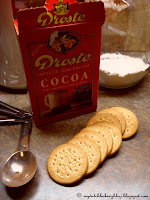 |
| Flipje is sharing Betuwe goodies with his friends. Image from www.levensmiddelenkrant.nl/ |
Arretje Nof was another one of those concoctions of the marketing agencies. The Nederlandse Olie Fabriek (Dutch Oil Factory, or NOF) published regularly booklets about the adventures of a young Arab boy called Arretje-NOF. The cartoons could be purchased by saving coupons with points that were printed on the packaging of NOF products. Not many remember the cartoons but the one thing that, to this day, appears prominently in traditional Dutch desserts is the so-called Arretje's Cake.
Our recipe includes raw eggs, but brings the batter up to 140F (60C) on the stove to make sure any pathogens are destroyed. Raw or undercooked eggs can be a safety risk. If you don't have a food thermometer, or want to be on the safe side, please use vanilla pudding or heavy cream as an alternative. Safety first!
Arretje's Cake
2 sticks butter (250 grm)
1 cup sugar (225 grm)
6 tablespoons cacao powder (40 grm)
2 eggs (or 1/4 cup of vanilla pudding or heavy cream)
2 oz dark chocolate
About 60 dry Maria cookies*
Melt the butter slowly in a sauce pan, until just melted, on low to medium heat. Mix the sugar and cacao in a separate bowl and set aside.
Beat the eggs well. Temper the eggs with some of the butter (pour in a little bit of the warm butter and stir into the eggs until it's incorporated) and keep adding the butter to the eggs until they're both mixed. Pour the mixture back into the sauce pan and take it back to the stove. Stir in the cocoa and sugar and keep stirring until they're blended into a thick chocolate sauce. Make sure all the sugar has dissolved. If you rub a little bit of the mixture between your thumb and index finger and it feels gritty, the sugar has not yet dissolved.
Grate the dark chocolate, or break it into small pieces and add it to the sauce pan. Keep stirring, and bring the temperature of the mixture up to 140F (60C) and keep it there, while stirring, for 3 1/2 minutes. If you are using vanilla pudding or heavy cream, you can skip this step. Just warm it up enough to melt the chocolate.
Take the sauce pan from the stove and let it cool a bit. In the meantime, add the cookies to a bag, or fold them into a clean towel, and roll your rolling pin over the cookies several times. You are looking to break the cookies into pieces no larger than a quarter.
Fold the cookies into the chocolate paste until they're all well covered. Line a cake pan with parchment paper or plastic film, spoon the mixture into the pan and flatten it with a spatula, making sure there are no air bubbles.
Cover and refrigerate for at least four hours, or overnight. Lift the cake out of the pan, and cut into thin slices. This cake is very rich!
* If you don't have Maria cookies, consider any other crisp cookie: iced oatmeal cookies, Oreos, or even Animal Crackers will work!


oohhhhh yummy! The greeks have something very similar which I made while living there. It was delicious and yes, rich tasting.
ReplyDeletenever heard of this cake before. Isn't that funny. I have heard of Arretje but his cake I never tasted. Flipje is back by the way.
ReplyDeletehttp://www.levensmiddelenkrant.nl/3011/flipje-terug-op-jampot
I have never heard about this before either. I might give it a try! And how exciting, a cooking blog as well. Bring on that recipe for bitterballen! :-)
ReplyDeleteCisca, so good to hear from you! Did you ever perfect that recipe for glacee cookies? I had arretjescake as a child, but in Limburg it's called "pletskeskook" so I didn't make the connection at first.
ReplyDeleteI made it yesterday...waaaaay to much sugar. It tasted like a hump of sugar with a brown color and some biscuit in it..maybe I did something wrong....
ReplyDeletethey have a same kind of recipe here in turkey where I live and they make little 'balls' of it. The only difference is no raw egg and way less sugar (just like 6 eat spoons) and like 100 ml milk I may try that recipe and put it in a cake form
I just came across the booklets my mother read to us when we where young I have four of five booklets the adventures of arretje nod. My Dutch is a little iffy but I remember those stories
ReplyDeleteI make it from a 60 year old "Delfia recipe Book". 250gr Copha {Delfia}, 200gr sugar, 50 gr Dutch Cocoa, 2 eggs, 200gr Maria's or milk arrowroot Biscuits I also like to add a teaspoon of disolved coffee to it & some people like to add grated coconut to it for a difference. Tip:- do not use plastic bowls etc to make it because the copha will not blend in properly. Use Stainless bowls & a wooden spoon to mix. {Delfia is made from coconut oil}
ReplyDelete